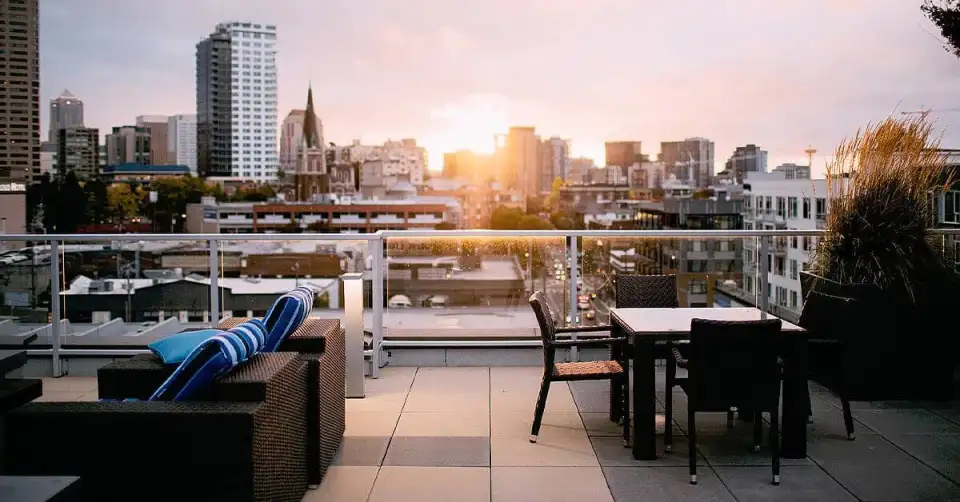
The average person living in the United States is believed to spend around 90% of their time indoors. For those who live in cities, it can sometimes feel like more than that—especially if they live in apartments without easy access to outdoor spaces.
While balconies can satisfy the most basic needs of someone looking for an outdoor space, they do have a lot of limitations. Depending on placement, they may not always receive sunlight throughout the day, they may sit directly beneath another balcony that obstructs a full view of the sky, and they are often only large enough to accommodate small pieces of furniture and a few potted plants.
Conversely, rooftop terraces provide far more options. They tend to have far better views of the surrounding cityscape; they receive more sunlight; and they can accommodate more people, furniture, and vegetation. In some cases, these spaces can even be converted into living roofs, complete with soil, drainage systems, and landscaping to create greenspaces capable of supporting herb and vegetable gardens. In multifamily buildings, these green rooftops also have the potential to become social areas where tenants can meet their neighbors or host friends and family. For single-family buildings with flat roofs, these areas should be considered blank canvases that can easily be converted into private oases.
Up On the Roof
Of course, getting on the roof is not always as easy as taking an elevator or climbing up a flight of stairs and walking through a rooftop bulkhead door. For existing buildings, especially townhouses and rowhomes with low pitch roofs that are under four stories, access may only be available if one climbs a shaky ladder and pops open a small hatch. In addition to potential safety issues for those going up or down the ladder, the hatch itself can become a security problem if it is not properly locked by the last person to use it. Consequently, many owners keep these hatches locked at all times, preventing anyone from getting either in or out.
However, allowing roof access and ensuring tenant safety are not mutually exclusive. Even owners with roof hatches can easily convert a bare rooftop into an outdoor sanctuary relatively easily, providing not only more useable space but also increasing the value of the property. All they need are the right permits and the right components.
Creating a Rooftop Haven
Before any work can begin, however, an architect and structural engineer must first check the integrity of the roof. In some cases, decking can be installed without the need for additional support; in other cases, the existing roof joists need to be reinforced or a new structure needs to be added to the existing roof. The team will also likely note if the existing parapets (if they exist at all) are sufficient or if additional guardrails need to be installed to comply with local codes.
Secondly, the roof membrane will need to be examined to see if it needs to be replaced. These barriers are critical components in low slope roofs, as they prevent water and moisture from seeping into the building. If the membrane is nearing the end of its lifespan, it may be wise to replace it. On the one hand, any measure to prevent water damage is money well spent, since even minor leaks can become very costly. On the other hand, replacing the membrane will become far more difficult once any decking or additional structures have been installed on top of it.

Finally, the team will need to design a way to allow easy access to the roof. For those without bulkhead structures, building one can be extremely costly—oftentimes in the realm of $100,000. Alternatively, roof hatches like those manufactured by Lamilux are more affordable, they have a smaller footprint than bulkheads, and can provide easy access onto any flat roof through a mechanized opening system. The Lamilux Flat Roof Access Hatch Comfort Swing, for example, has dimensions of either 100 cm x 300 cm or 100 cm x 350 cm (39.37 in x 118.11 or 39.37 in x 137.8, respectively) and opens to 84° in just 25 seconds with the flick of a switch. The model also comes in a variety of colors.
From a performance perspective, the steel frame of the Comfort Swing is insulated throughout with mineral wool and without thermal bridges, while the triple-pane glazing provides optimal thermal and acoustic comfort (Ug-vale of 0.6 W/(m2K) and a dB rating of 39). The Comfort Swing also provides natural light similar to any skylight and can be customized to adjust total energy transmission depending on climate and orientation. It also comes equipped with an external shading system that can be activated to prevent overheating.

For those in landmarked areas, the Comfort Swing has the additional benefit of a very low profile (50 cm or 19.685 in), meaning it typically not being visible from the street whereas bulkhead structures often are. Consequently, installation of the former may not require approval from landmark commissions, whereas construction of the latter almost certainly will. Seeking approval from these boards can mean not only additional costs, but also significant delays and frustrations.
Of course, the Comfort Swing is not only for historic buildings. It can be installed on any flat roof to allow easy access to the terrace while providing the space below with abundant natural light without compromising building performance.